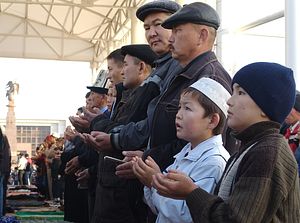At a workshop hosted by George Washington University’s Central Asia Program, John Heathershaw, an associate professor in international relations at the University of Exeter, and David Montgomery, a visiting assistant professor in anthropology at the University of Pittsburgh, discussed the findings of their report, released last November by Chatham House, The Myth of Post-Soviet Muslim Radicalization in the Central Asian Republics. Heathershaw and Montgomery were joined by three discussants–Marlene Laruelle of GWU, Noah Tucker of Registan.net, and Michael Hall of the Open Society Foundation–who offered insightful comments about the report and its implications.
In light of the veritable explosion of commentary on Islamic extremists–namely ISIS–in Central Asia the report, commented Tucker, was perhaps ahead of its time. In the report, Heathershaw and Montgomery say that Central Asia is commonly discussed as having a “widespread and increasing problem with ‘Muslim radicalization’,” but that “there is no evidence of significant levels of Islamic extremism and political violence in the region.”
Heathershaw and Montgomery don’t argue that violent extremism does not exist at all in Central Asia–it does–instead they argue that conflating Islamization and radicalization leads to irrelevant, or worse, detrimental policy choices. They break this “myth” of Muslim radicalization into six claims and then proceed to discuss each in detail, identifying flaws in the arguments used by international security analysts and regional governments.
The six myths are:
- There is a post-Soviet Islamic revival;
- To Islamicize is to radicalize;
- Authoritarianism and poverty cause radicalization;
- Underground Muslim groups are radical;
- Radical Muslim groups are globally networked;
- Political Islam opposes the secular state.
The basic tenet of social science is that correlation does not necessarily indicate causation. So why, they ask, do security analyses of the region link the “relatively small number of Muslim individuals and groups committing violent acts” there to a broader trend?
If these six statements are myths, what, then is happening in Central Asia? The researchers and discussants took the report a step further and offered thoughts on what is happening in the region.
Two points stuck out in particular: that there is a much larger conservative-values movement across the post-Soviet space that includes, but supersedes, Islam and that regional governments have a history of deliberately misinforming their people and partners with regard to the threat of radical Islam.
Laruelle and Hall both noted that there is a general rise in conservatism–family values, gender roles, anti-corruption narratives–across the former Soviet Union, and it is much larger than the simply a rise in religious values. Hall added that at times, this rise in conservatism takes on religions manifestations but they are not always Islamic–he pointed to protests in Georgia in 2013, led by priests. The two–conservatism and Islam–however, are often conflated. Islam is referenced in terms of morality, but usually under law in the region. Laruelle mentioned a recent survey which found that 30 percent of the population in Tajikistan and Kyrgyzstan wanted sharia law:
Of course, when you ask the question ‘what do you understand by sharia?’ Then you will have very large definition of what is sharia. We see that people asking for sharia to be introduced in the legal system usually want it for family issues and for business-related issues.
Tucker outlined the deliberate disinformation campaign pursued by regional governments, recounting that when the locus of the Islamic threat to the region was the Islamic Movement of Uzbekistan, several regional governments felt the need “to expand the danger of the IMU in order to justify domestic policies.” They did this by claiming that that movement had renamed itself the Islamic Movement of Turkestan:
And there’s one country in particular where it is referred to this consistently this way in the press and has been for three or four years in spite of the fact that IMU never renamed themselves the Islamic Movement of Turkestan, they’ve never called themselves… this verifiably did not happen. But these governments claimed to have secret sources within the organization that tell them these things that make the threat seem all the more ominous and create this idea that their population is surrounded by this radical Islamic threat.
“And now” Tucker continued, “the dialogue about that abruptly changed to ISIS.” In Tajikistan in particular a rumor abounded ahead of the parliamentary elections that there were ISIS troops across the border in Afghanistan, readying an invasion:
….this was then parlayed into a link supposedly between the IRPT and ISIS. The discourse of this is “a vote for the IRPT is a vote for ISIS.” This is so far off the rails, and so I think we have to say deliberately deceptive.
Hall commented that “we need a more nuanced, and balanced, and contextual picture of what’s going on” in the region. This is of course, made more difficult by deliberate disinformation on the part of regional governments and lack of on-the-ground data. Indeed, Heathershaw, Montgomery, and the discussants all seemed to agree that a more nuanced understanding of the relationship between secularism, Islam, and the state in Central Asia is needed and that the policies of western nations–particularly the U.S. and the UK–ought to be more prudent, especially when it comes to supplying regional governments with military equipment and training.
The report is available for download here, and a Russian version will be released in the coming months for regional distribution.

































